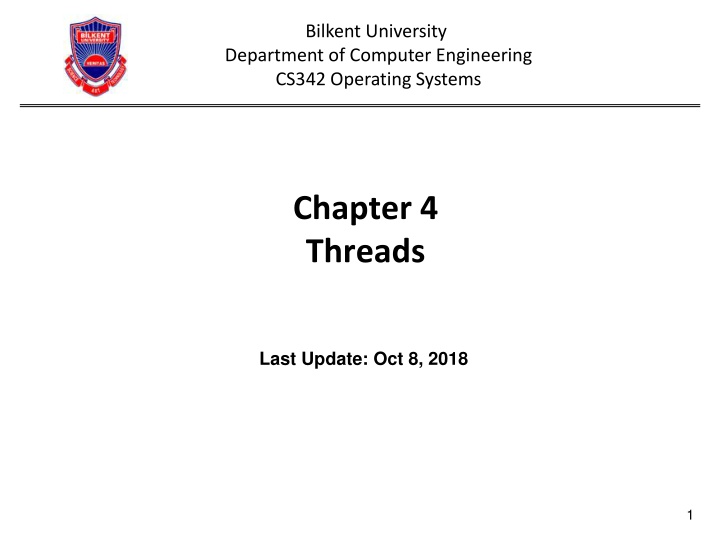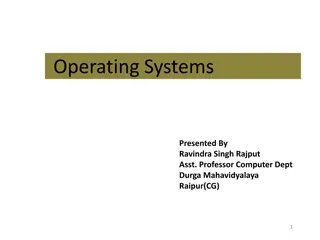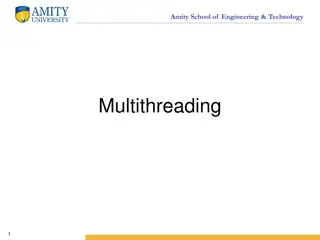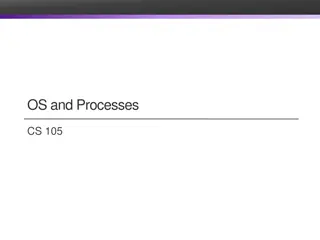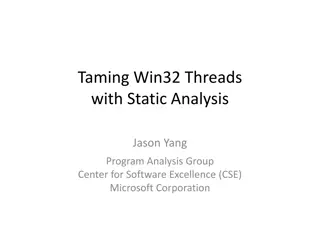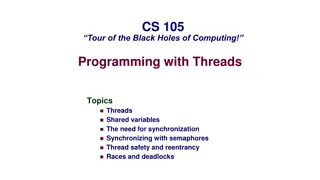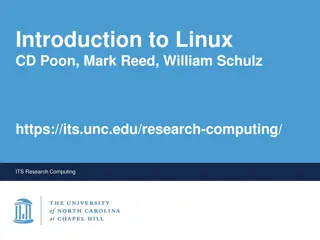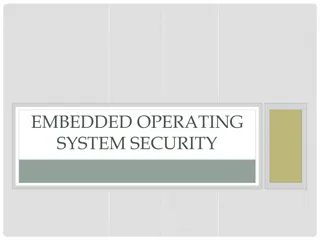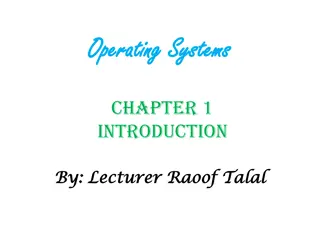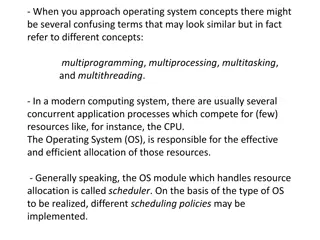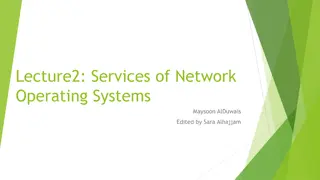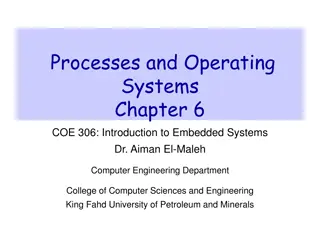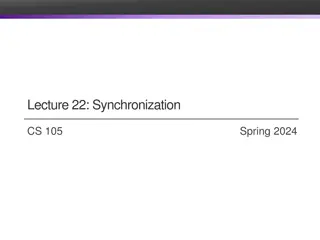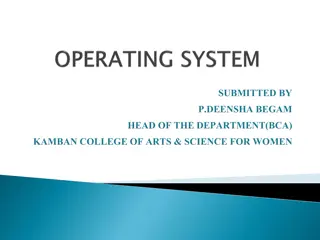Multithreading in Operating Systems
This content delves into the concept of multithreading in operating systems, covering topics such as thread models, libraries, threading issues, and examples from Windows XP and Linux. Explore the benefits of using threads for improved responsiveness, resource sharing, economy, and scalability in applications. Understand how threads enable concurrent activities within a process, enhancing CPU utilization and performance.
Download Presentation

Please find below an Image/Link to download the presentation.
The content on the website is provided AS IS for your information and personal use only. It may not be sold, licensed, or shared on other websites without obtaining consent from the author.If you encounter any issues during the download, it is possible that the publisher has removed the file from their server.
You are allowed to download the files provided on this website for personal or commercial use, subject to the condition that they are used lawfully. All files are the property of their respective owners.
The content on the website is provided AS IS for your information and personal use only. It may not be sold, licensed, or shared on other websites without obtaining consent from the author.
E N D
Presentation Transcript
Bilkent University Department of Computer Engineering CS342 Operating Systems Chapter 4 Threads Last Update: Oct 8, 2018 1
Outline and Objectives Outline Overview Multithreading Models Thread Libraries Threading Issues Operating System Examples Windows XP Threads Linux Threads Re-entrancy Thread specific data Objectives To introduce the notion of a thread a fundamental unit of CPU utilization that forms the basis of multithreaded computer systems To discuss the APIs for the Pthreads, Win32, and Java thread libraries To examine issues related to multithreaded programming 2
Threads and Thread Usage A process has normally a single thread of control (execution sequence/flow). Always at least one thread exists If blocks, no activity can be done as part of the process Better: be able to run concurrent activities (tasks) as part of the same process. Now, a process can have multiple threads of control (multiple concurrent tasks). Threads run in pseudo-parallel manner (concurrently), share text(code) and data 4
Benefits of using threads for an App Responsiveness One thread blocks, another one runs. One thread may always wait for the user Resource Sharing Threads can easily share resources Economy Creating a thread is fast Context switching among threads may be faster Scalability Multiprocessors can be utilized better 5
Threads and Thread Usage data data CPU blocks blocks blocks code code blocks run enough single-threaded process multi-threaded process 6
a multithreaded process execution flows: threads Instructions of the Program main() Thread0 Thread2 Thread1 time Lifetime of the process 7
Multithreading Concept CPU single-threaded process multi-threaded process 8
Multithreading Concept Process Process thread thread thread thread P1.T1 P2.T2 P2.T1 P2.T3 Schedulable Entities We can select one of them and run 9
Multithreading Concept thread1 thread2 thread3 thread4 function1( ) { { . function2( ) { { . main() { } . thread_create (function1 , ); . thread_create (function2, ); . thread_create (function1, ); . 10
Multicore programming and multithreading challenges Multicore systems putting pressure on programmers. Threading can utilize Multicore systems better, but it has some challenges Threading Challenges include Dividing activities Come up with concurrent tasks Balance Tasks should be similar importance and load Data splitting Data may need to be split as well Data dependency Data dependencies should be considered; need synchronization of activities Testing and debugging Debugging is more difficult 12
Speedup: Amdahls Law Potential performance gain (speed up) with multiple cores (CPUs)? Program: both serial and parallel parts Assume the program executes and finishes in 1 time unit. S: time to execute the serial portion (0 <= S <= 1) 1-S: is the runtime of the portion that can be parallelized N: number of processing cores. N tasks can run in parallel. Then parallelizable portion of the program will finish N times faster 1 speedup S+ (1-S)/ N [ ] 16
Threading Support Multithreading can be supported by: User level libraries (without Kernel being aware of it) Library creates and manages threads (user level implementation) Kernel itself Kernel creates and manages threads (kernel space implementation) No matter which is implemented, threads can be created, used, and terminated via a set of functions that are part of a Thread API (a thread library) Three primary thread libraries: POSIX threads, Java threads, Win32 threads 18
Multithreading Models A user process wants to create one or more threads. Kernel can create one (or more) thread(s) for the process. Even a kernel does not support threading, it can create one thread per process (i.e., it can create a process which is a single thread of execution). Finally a relationship must exist between user threads and kernel thread(s) Mapping user level threads to kernel level threads Three common ways of establishing such a relationship: Many-to-One model One-to-One model Many-to-Many model 19
Many-to-One Model: Implementing Threads in User Space Many user-level threads mapped to a single kernel thread Examples: Solaris Green Threads GNU Portable Threads Thread management done at user space, by a thread library Kernel supports process concept; not threading concept 20
Many-to-One Model: Implementing Threads in User Space No need for kernel support for multithreading (+) Thread creation is fast (+) Switching between threads is fast; efficient approach (+) Blocking system calls defeat the purpose and have to be handled (-) A thread has to explicitly call a function to voluntarily give the CPU to some other thread (-) example: thread_yield() Multiple threads will run on a single processor, not utilizing multi- processor machines. (-) Thread Process A Process B Run-time System (library) Thread table PCB A PCB B process table Kernel 21
One-to-One Model: Implementing Threads in Kernel Space Kernel may implement threading and can manage threads, schedule threads. Kernel is aware of threads. Examples (nearly all modern OSs): Windows, Linux, All these kernels have threading support. They can schedule processes and their threads (not only processes) Each user-level thread maps to a kernel thread 22
One-to-One Model: Implementing Threads in Kernel Space Provides more concurrency; when a thread blocks, another can run. Blocking system calls are not problem anymore. (+) Multiple processors can be utilized as well. (+). Kernel can stop a long running thread and run another thread. No need for explicit request from a thread to be stopped. (+) Need system calls to create threads and this takes time; (-) thread switching costly; (-) any thread function requires a system call. (-) Process A Process B PCB A PCB B process table Kernel Thread table 23
Thread Libraries Thread library provides programmer with API for creating and managing threads Programmer just have to know the thread library interface (API). Threads may be implemented in user space or kernel space. library may be entirely in user space or may get kernel support for threading 25
Pthreads Library Pthreads: POSIX threads May be provided either as user-level or kernel-level A POSIX standard (IEEE 1003.1c) API for thread creation and synchronization API specifies behavior of the thread library, implementation is up to development of the library Common in UNIX-like operating systems (Solaris, Linux, Mac OS X) 26
Pthreads Example We will show a program that creates a new thread. Hence a process will have two threads : 1 - the initial/main thread that is created to execute the main() function (that thread is always created even though there is no support for multithreading); 2 - the new thread. (both threads have equal power) The program will just create a new thread to do a simple computation: will sum all integers upto a given parameter value sum = 1+2+ +parameter_value N = i = sum i 1 The main thread will wait until sum is computed into a global variable. Then the main thread will print the result. 27
Pthreads Example #include <pthread.h> #include <stdio.h> int sum; /* shared sum by threads global variable */ void *runner (void *param); /* thread start function */ 28
Pthreads Example int main(int argc, char *argv[]){ pthread_t tid; /* id of the created thread */ pthread_attr_t attr; /* set of thread attributes */ if (argc != 2) { fprintf (stderr, usage: a.out <value>\n ); return -1; } if (atoi(argv[1]) < 0) { fprintf (stderr, %d must be >= 0\n , atoi(argv[1]); return -1; } pthread_attr_init (&attr); pthread_create (&tid, &attr, runner, argv[1]); pthread_join (tid, NULL); printf ( sum = %d\n , sum); } 29
Pthreads Example void *runner (void *param) { int i; int upper; upper = atoi(param); sum = 0; for (i = 1; i <= upper; ++i) sum += i; } pthread_exit(0); 30
Pthreads Example int main( ) { thread1 thread2 . pthread_create(&tid, ,runner,..); wait pthread_join(tid); . } printf ( , sum, ); runner ( ) { { . sum = pthread_exit(); 31
Compiling and running the program You can put the above code into a .c file, say mysum.c In order to use the Pthreads functions, we need to include pthread.h header file in our program (as shown in previous slides) We also need to link with the pthread library (the Pthreads API functions are not implemented in the standard C library). The way to do that is using the l option of the C compiler. After l you can provide a library name like pthread. Hence we can compile+link our program as follows: gcc -Wall -o mysum -lpthread mysum.c Then we run it as (for example): ./mysum 6 It will print out 21 32
Java Threads Java threads are managed by the JVM Typically implemented using the threads model provided by underlying OS Java threads may be created by: Extending Thread class Implementing the Runnable interface Example given in the book 34
From Single-threaded to Multithreaded Scope of variables: Normally we have: global, local With threads, we want: global, local, and thread-specific (thread wide) thread-specific: global inside the thread (thread-wide global), but not global for the whole process. Other threads can not access it. But all functions of the thread can. But we may not have language support to define such variables. C can not do that. Normally in C we have just global variables and local variables. We do not have thread-wide (thread-local or thread-global) variables. Therefore thread API has special functions that can be used to create such variables data. This is called thread specific data. 35
Thread Specific Data Allows each thread to have its own copy of data Each thread refers to the data with the same name. Example: Each thread can do: create_global ( bufptr ); // create pointer to such a variable Allocated space for buf set_global ( bufptr , &buf); // set the pointer bufptr = read_global ( bufptr ); // get the pointer to access // use bufptr to access own data Here bufptr is the same name of the variable used in each thread. But each thread has its own copy of data. 36
From Single-threaded to Multithreaded Many programs are written as a single threaded process. If we try to convert a single-threaded process to be a multi-threaded process, we have to be careful about the following: the global variables the library functions we use 37
From Singlethread to Multithreaded int status; // a global variable func1( ) { } . status = do_something_based_on(status); This is a single threaded program func2( ) { } main() { } status = do_something_based_on(status); . func1 ( ); func2 ( ); 38
From Singlethread to Multithreaded int status; We can have problem here. func1( ) { } . status = do_something_based_on(status); Just after func1 of thread 1 updated status, a thread switch may occur and 2nd thread can run and update status. func2( ) { } main() { } status = do_something_based_on(status); Then thread 1 will run again, but will work with a different status value. Wrong result! . thread_create( , func1, ); thread_create( , func2, ); 39
Thread-safe / Reentrant libraries Many library procedures may not be reentrant. They are not designed to have a second call to itself from the same process before it is completed (not re-entrant). (We are talking about non-recursive procedures.) They may be using global variables. Hence may not be thread-safe. We have to be sure that we use thread-safe (reentrant) library routines in multi-threaded programs we are developing. 40
Operating System Examples Windows XP Threads Linux Threads 42
Linux Threads Linux refers to them as tasks rather than threads Thread creation is done through clone() system call clone() allows a child task to share the address space of the parent task (process) 43
Clone() and fork() user program clone() library fork() sys_fork() { } sys_clone(){ } . kernel 44
References The slides here are adapted/modified from the textbook and its slides: Operating System Concepts, Silberschatz et al., 7th & 8th editions, Wiley. Operating System Concepts, 7th and 8th editions, Silberschatz et al. Wiley. Modern Operating Systems, Andrew S. Tanenbaum, 3rd edition, 2009. 45
Many-to-Many Model & Two-level Model Many-to-Many Model Allows many user level threads to be mapped to many kernel threads Allows the operating system to create a sufficient number of kernel threads Solaris prior to version 9 Windows NT/2000 with the ThreadFiber package Two-level Model Similar to M:M, except that it allows a user thread to be bound to a kernel thread Examples IRIX HP-UX Tru64 UNIX Solaris 8 and earlier 47
Implicit Threading Applications can create hundreds or thousands of threads. Can be creating explicitly. (App programmer worries) Can be created by compiler, library, platform, etc. (easier for App programmer) - called Implicit Threading. Some alternatives for implicit threading Thread Pools OpenMP (Compiler Supported) Grand Central Dispatch (in Mac OS X) 49
Thread Pools Create a number of threads in a pool where they await for work Advantages: Faster Limit the count of threads: Allows the number of threads in the application to be bound to the size of the pool 50
